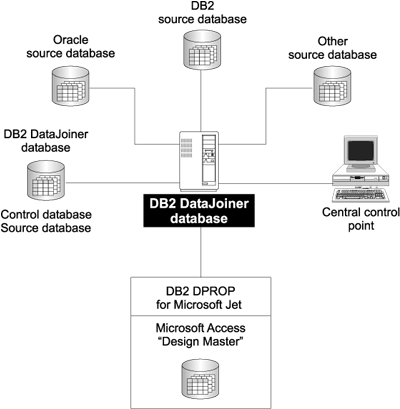

DataPropagator for Microsoft Jet extends the DB2 DataPropagator solution to support Microsoft Access and Microsoft Jet databases in LAN, occasionally connected, and mobile environments. Without any programming, you can replicate your server data into Microsoft Access tables for both browsing and updating.
DataPropagator for Microsoft Jet is a single executable that contains both the Capture and Apply capability and a portion of the administration facility. DataPropagator for Microsoft Jet runs on a client machine under Microsoft Windows NT or Windows 95, and reaches source databases via DB2 Client Application Enabler (CAE). DataPropagator for Microsoft Jet is packaged as part of DB2 DataJoiner Version 2 Release 2.1 (although you do not need to install a DB2 DataJoiner server to use this software) but also works with DB2 Universal Database (DB2 UDB), DB2 Common Server V2, and DB2 Connect. DataPropagator for Microsoft Jet requires the DataJoiner Replication Administration tool (DJRA) at the control point.
DataPropagator for Microsoft Jet replicates relational tables to and from Microsoft Jet databases, and detects and records any update conflicts (using the Microsoft Jet replication model). The source server can be DB2 or any non-DB2 replication sources defined through DB2 DataJoiner. The control server must be a DB2 or DB2 DataJoiner database. For more information about DB2 DataJoiner and the DataJoiner Replication Administration tool, see The DB2 DataJoiner Replication Administration tool.
Figure 17 illustrates how DataPropagator for Microsoft Jet supports replication of Microsoft Access and Microsoft Jet databases.
Figure 17. Microsoft Jet Database Replication
 |
A small DBMS with a replicated subset of a larger corporate database enables service employees and mobile professionals to run meaningful desktop applications while disconnected from a server network. These users connect to their corporate network only occasionally, and usually only long enough to synchronize their desktop database, e-mail, and messaging services with the corporate servers. For more information about subsets, see Subsetting columns and rows.
DataPropagator for Microsoft Jet administration doesn't require a direct connection to a Microsoft Jet database for administration. The DJRA tool maintains control information in the control server database. DataPropagator for Microsoft Jet running on a laptop is able to create Microsoft Jet databases, tables, and additional columns, and drop tables and old columns based on the current state of the control information in the server. To deploy a Microsoft Jet application, the application, database, and replication software must be installed before you distribute the laptop computers. However, the Microsoft Jet database does not need to be created in advance.
You can define or redefine replication source and subscription definitions for a Microsoft Jet database at any time, using DJRA, before or after you distribute the laptops for asynchronous processing by DataPropagator for Microsoft Jet.
If you have problems with your laptop, you can rebuild your Microsoft Jet database, tables, and contents by deleting the Jet database and resynchronizing using DataPropagator for Microsoft Jet. DataPropagator for Microsoft Jet can automatically rebuild your database.
For more information about usage scenarios involving mobile replication, see Occasionally connected.
Within a network of DB2 databases, DB2 DataPropagator supports an update-anywhere model that is able to detect transaction conflicts. DataPropagator for Microsoft Jet supports an update-anywhere model, but with weaker row-conflict detection (similar to the standard Microsoft Jet model). If you choose to use DataPropagator for Microsoft Jet, you should be both familiar and comfortable with the standard Microsoft Jet replication model.
DataPropagator for Microsoft Jet reports synchronization conflicts in conflict tables in a very similar way to the built-in Microsoft Jet replication feature. This process can result in a loss of updates. If you use the single-user version of the DB2 Universal Database server on your laptop, for example, your application is assured of all-or-nothing transaction semantics when synchronizing with corporate servers. However, if you use Microsoft Jet as your mobile database, synchronization conflicts are handled on a row-by-row basis, so updates might be lost. Therefore, some updates might be flagged as conflicting while other updates propagate to the corporate database. If this situation is not acceptable, you need to program your own resolutions for all potential update conflicts. For more information about how DataPropagator for Microsoft Jet handles conflict errors, see Error recovery. For more information about programming your own resolutions, refer to the appropriate Microsoft documentation.
The following terms represent replication concepts as they pertain to Microsoft Jet database replication. For definitions of general replication terms, see Glossary.